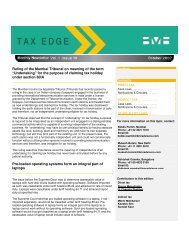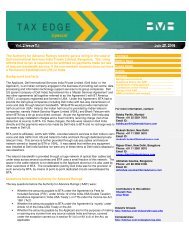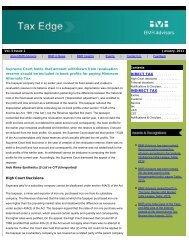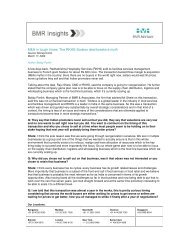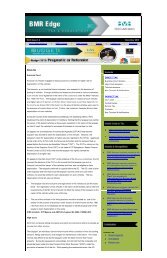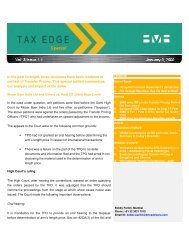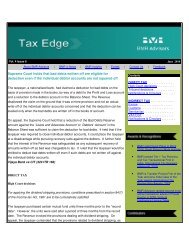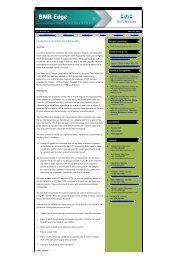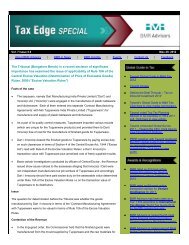Corporate Tax 2010 - BMR Advisors
Corporate Tax 2010 - BMR Advisors
Corporate Tax 2010 - BMR Advisors
You also want an ePaper? Increase the reach of your titles
YUMPU automatically turns print PDFs into web optimized ePapers that Google loves.
Bustamante & Bustamante<br />
Ecuador<br />
Ecuador<br />
from income tax in the terms explained in the answer to question<br />
3.1 above. If the shareholders at their annual meeting approve the<br />
reinvestments of profits and meet the applicable requirements, as<br />
explained in the answer to question 4.1 above, the company may<br />
benefit from a reduction in income tax to 15% levied on the amount<br />
of profits reinvested, instead of the normal 25% corporate tax rate.<br />
4.7 What other national taxes (excluding those dealt with in<br />
“Transaction <strong>Tax</strong>es”, above) are there - e.g. property taxes,<br />
etc.<br />
4.7.1. Superintendency of Companies contribution: all companies<br />
subject to the oversight of the Superintendency of Companies must<br />
pay an annual contribution of up to 0.1% over assets, with the<br />
Superintendency having the power to set such contribution within<br />
this limit. Presently, the Superintendency has set the contribution<br />
within a range of 0.065% to 0.085% over tangible assets.<br />
4.7.2. Production chamber dues: companies organised in Ecuador<br />
must be affiliated with a production chamber and pay annual or<br />
monthly dues, as the case may be, which vary depending on the<br />
chamber of affiliation and the capital of the member company.<br />
4.7.3. In accordance with the Labour Code, workers are entitled to<br />
participate in 15% of the profits, before taxes, earned by the<br />
company for which they work. Although the workers’ share is not<br />
a tax but rather a labour burden, its effect upon the company’s<br />
earnings is equal to that of a tax. It should be noted that employee<br />
profit-sharing is a deductible expense when determining the tax<br />
base subject to income tax.<br />
4.7.4. A Capital Exit <strong>Tax</strong> is levy at a rate of 1% on every payment,<br />
credit or cash remitted abroad. Under this new law, there are no<br />
exemptions for import and foreign loan payments.<br />
4.8 Are there any local taxes not dealt with in answers to<br />
other questions<br />
a) <strong>Tax</strong> on total fixed assets:<br />
Natural or juridical persons who ordinarily engage in commercial,<br />
industrial and financial activities for which they must keep books,<br />
pursuant to the rules of the Internal <strong>Tax</strong> Regime Law, are required<br />
to pay the municipality where they carry out their activities an<br />
annual tax equal to 0.15% of their total assets, for which they may<br />
deduct only current liabilities and contingent liabilities. When a<br />
company’s activities are carried out in two or more counties, the tax<br />
is distributed among all of the counties where the company<br />
operates.<br />
b) Property tax:<br />
The value of urban property is subject to a percentage tax<br />
fluctuating between a minimum of 0.25% and a maximum of<br />
0.5%, which is determined in an ordinance by each<br />
municipal council in whose jurisdiction the taxed immovable<br />
property is located.<br />
The value of rural property is subject to a percentage tax<br />
fluctuating between a minimum of 0.25% and a maximum of<br />
0.3%, which is set in an ordinance by each municipal<br />
council.<br />
Municipal patent: all merchants and industrialists operating<br />
in a county as well as those engaging in any economic<br />
activity are obligated to obtain an annual patent from the<br />
municipality where they carry out their activities. Each<br />
municipality issues an ordinance stating the annual tax rate<br />
based on the operating capital of the taxpayers within the<br />
county. The minimum rate is US$10 and the maximum<br />
US$5,000.<br />
Transfer tax on immovable property: the base for<br />
calculating this tax is the contract price. If the price is less<br />
than the property appraisal stated in the cadastre, the latter<br />
will prevail. One percent is applied over the tax base. <strong>Tax</strong>es<br />
in addition to the property taxes created or to be created by<br />
special laws are charged together with the main tax unless<br />
the law creating them stipulates collection by another agent<br />
of the municipal treasury. The amount of the additional tax<br />
cannot exceed fifty percent of the base rate determined in the<br />
preceding article, and the sum of additional taxes cannot<br />
exceed one hundred percent of the base rate. In the case it<br />
does, only an amount equal to said one hundred percent will<br />
be charged and will be distributed among the participants.<br />
Increased property value tax: municipalities are entitled to<br />
charge a 10% tax on the gain from the sale of urban<br />
immovable property. In addition to other deductions<br />
considered for determining the tax base, for each year after<br />
the second year counted from the date of purchase, 5% will<br />
deducted each year and this tax cannot be charged after<br />
twenty years of the purchase.<br />
5 Capital Gains<br />
5.1 Is there a special set of rules for taxing capital gains and<br />
losses<br />
No. Although exempt from income tax, income resulting from the<br />
occasional sale of immovable property, stock or equity interest is<br />
subject to income tax when earnings are the result of transactions<br />
pertaining to the normal course of the taxpayer’s business or its<br />
ordinary activities. Capital gains or eventual losses incurred must<br />
be reflected in the company’s financial statements and are subject to<br />
the general rules regulating the determination of the tax base and<br />
applicable income tax.<br />
5.2 If so, is the rate of tax imposed upon capital gains<br />
different from the rate imposed upon business profits<br />
This is not applicable in Ecuador. Please see the answer to question<br />
5.1.<br />
5.3 Is there a participation exemption<br />
The only exemption provided under Ecuadorian <strong>Tax</strong> Law concerns<br />
the occasional gains resulting from the sale of immovable property,<br />
stock or equity interest, as explained in question 5.1 above. If not<br />
exempt, capital gains will be included in the company’s tax base<br />
and taxed accordingly at the 25% rate when earnings are not<br />
reinvested, as explained in question 4.1.<br />
5.4 Is there any special relief for reinvestment<br />
No, there is no special relief for reinvestment.<br />
6 Branch or Subsidiary<br />
6.1 What taxes (e.g. capital duty) would be imposed upon the<br />
formation of a subsidiary<br />
The formation of subsidiaries is not subject to taxes.<br />
78<br />
WWW.ICLG.CO.UK<br />
ICLG TO: CORPORATE TAX <strong>2010</strong><br />
© Published and reproduced with kind permission by Global Legal Group Ltd, London







